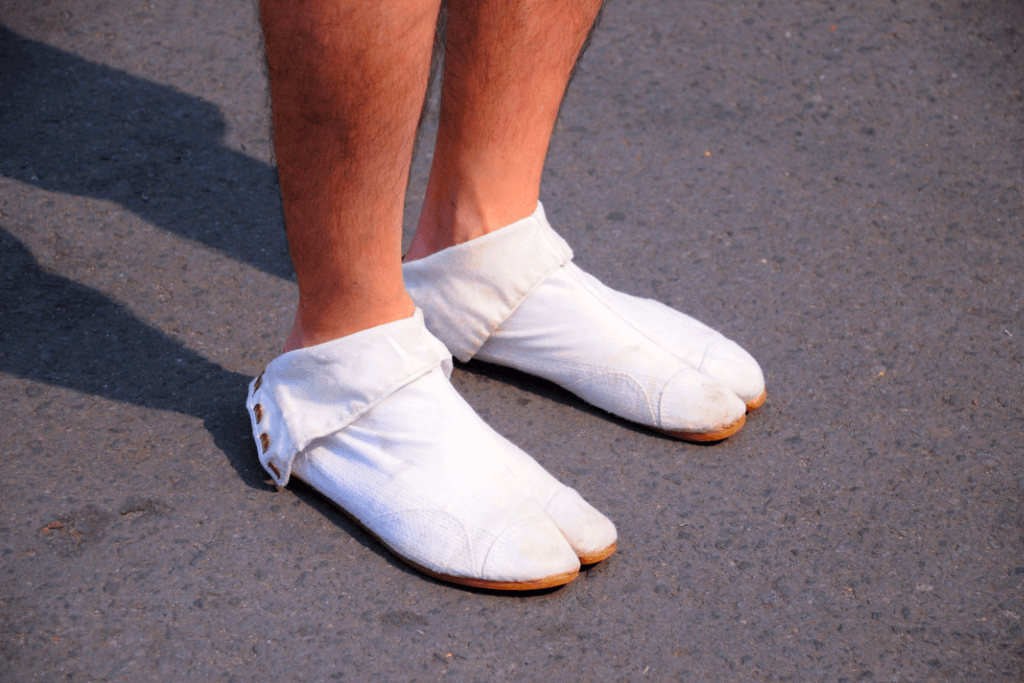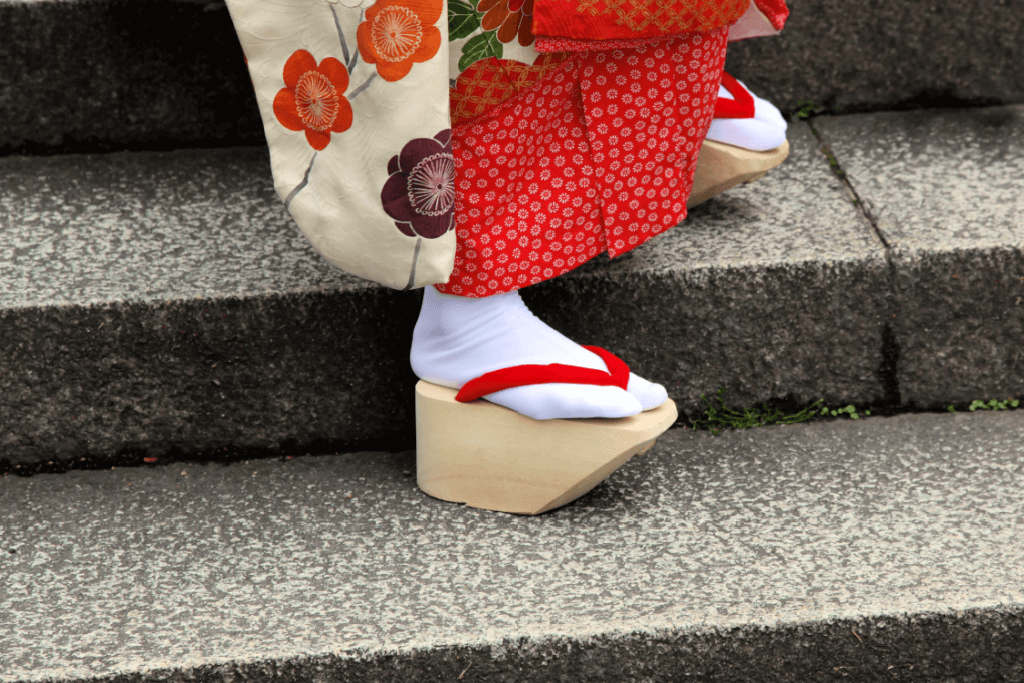culture, geta, jika tabi, okobo, tabi, waraji, warazori, zori
Tabi: Exploring the Unique Split-Toe Shoes of Japan and More!

Tokyo Terry
Posted on August 30, 2023
Share:

Tabi are traditional split-toe Japanese shoes that are a significant part of fashion and history. Many people wear them because they naturally move with the feet, which benefits posture and can prevent foot injuries. They come in the form of boots, shoes, and even sandals. Let’s look closer at these tabi and similar shoes and sandals that people wear all year round!
Jika Tabi
Jika tabi gave rise to modern tabi socks. Originally crafted entirely from leather, these split-toed boots offered enhanced foot protection for individuals engaged in outdoor activities like farming, fishing, hunting, and military duties. Since early versions lacked reinforced soles, the split-toe design enabled wearing jika tabi with waraji sandals for added safeguarding. Gradually, materials like leather, woven straw, and eventually rubber were directly stitched onto the soles of jika tabi boots.

They became popular in the Edo period but are still used in Japan today in numerous professions. They are more flexible than regular work boots, making them the footwear of choice for climbing professions such as gardening, tree trimming, and construction. New versions of jika tabi are still being developed; some construction versions are now steel-tipped to combine flexibility with added protection.
Tabi Socks, Sneakers and Shoes
Tabi socks have been used in Japan since the Nara period. The first versions used laces or buttons to keep them attached to the feet. They were usually dark when first introduced, making dirt and stains less visible. When tabi became popular among geisha, kabuki actors, nobles, and royal court members, the original materials were replaced with cotton.

Additionally, these socks became a symbol of the elite. These more refined tabi socks were kept on the feet using metal clasps, a feature still in modern tabi socks. Once they became part of Japanese culture and symbolism, white tabi socks became the standard for formal ceremonies and occasions.

The tabi design has many advantages over other forms of footwear. When walking barefoot, the foot naturally spreads to create three points of contact: the big toe, little toe, and heel. Tabi shoes allow the foot to grip independently with the toes, increasing mobility and balance. Research has also shown that wearing tabi shoes regularly improves posture and increases toe and foot strength.
These factors affect performance and are of particular importance to athletes. For cross-country runners significantly, the ability to feel and naturally react to uneven surfaces of varying textures can improve running times and reduce the risk of injury. Many companies are taking note of these points and are now applying the tabi design to sneakers and formal dress shoes.
Are you interested in enjoying traditional snacks from Japan? Check out Sakuraco! Sakuraco sends traditional Japanese sweets, snacks, and tableware from across Japan to your door so that you can enjoy the experience!
Waraji and Warazori
Waraji, the earliest form of Japanese footwear, likely existed before its documented appearance in the 8th century. Artisans wove ropes into soles and toe straps to create these simple shoes, resulting in a design characterized by enduring simplicity.
These woven shoes came in various patterns, primarily ankle-tied and foot-tied. They were most suitable for outdoor activities. Because waraji were simple to assemble, people could quickly repair them when necessary. However, this flexibility came at a cost, as waraji made from delicate rice straw could only withstand a few days of heavy use before wearing out.

Waraji were the first type of shoes in Japan, and they hold a lot of traditions and celebrations. Back when people traveled mainly by walking, they often risked severe foot injuries. So, people would give waraji to temples and pray for their feet to be safe on the trip. Even today, you can still see these special shoes hanging in temples as offerings. Buddhist monks also wear them on their journeys, keeping an old practice alive.
These shoes are also a big part of matsuri (Japanese festivals). Some festivals are only about these shoes. They even have a big waraji called o-waraji that they give to temples or put into the sea. On the other hand, warazori are a bit different. They’re like waraji but without straps around the ankles. They’re more like slippers than sandals. In the past, people used them for everyday life in places where they didn’t need to do hard work or walk a lot on rough paths. As a result, they’re a little less common today.
Zori
Zori are a refinement of the plain warazori. During the culturally rich Edo period, warazori became more accepted as footwear and became more elaborate. Gradually, cloth, leather, and wood started to replace the woven rice and straw fiber soles.

Eventually, people exchanged these rope straps for hanao–colorful cloth straps with elaborate embroidery. Zori transitioned from a footwear staple to a status symbol, and professional manufacturers enabled its popularity. It became acceptable to wear zori even with a formal kimono, a practice still upheld today. You can even find some zori at flea markets!
Geta
Geta are one of the most versatile everyday shoes in Japan. Like waraji, it is uncertain when geta was first used. Straw waraji rot quickly, making them difficult to find at archeological sites. On the other hand, geta use wood, which is more durable than straw. For this reason, ancient geta have been found that are over 5000 years old. They started appearing in Japanese history in the 8th century, likely imported from China by merchants and traders.

These shoes utilize hanao to attach the foot to a wooden sole. However, there are no other straps, which results in the characteristic shuffling walking style and unique sound commonly associated with geta. Due to their loose fit and clunky sole, geta are unsuitable for outdoor work and find use in less demanding environments. Their wooden soles last longer than woven soles, providing more protection when walking over rocky ground.
As geta became more commonplace, different styles developed. Thicker wooden soles wore out more slowly but were more expensive. Thicker soles became associated with wealth. As fashion evolved in Japanese society, geta height became tied to wealth.
Geisha and women in high society wore them to prevent their delicate kimono from dragging along the ground. Over time, two “teeth” were added to the underside to increase height while reducing weight. The teeth’ height came to represent status, and geta became a permanent part of Japanese culture. In old paintings, even the mythical tengu can be seen wearing a one-toothed tengu geta.
Okobo: The Geisha Geta
At first glance, okobo appear identical to geta; they both have raised wooden soles attached to the foot by a strap alongside the big toe. Unlike geta, okobo shoes lack separated wooden teeth for elevation. Additionally, while the wooden soles of okobo appear solid, they are hollow inside to minimize weight, with a slant at the front.

Okobo are mainly women’s shoes. When worn by a woman or girl who is not a geisha (traditional Japanese performing artist) or maiko (apprentice geisha), the wooden soles are not as high, and the sides of the soles can be decorated. These details are still present at coming-of-age ceremonies, as okobo are still popular today.
The wooden okobo soles worn by maiko can be up to 10 cm in height, and the straps must be plain. The color of the straps is of great significance; the new maiko wears red straps, while the senior maiko wears yellow straps.
Why should I wear tabi shoes?
Tabi shoes offer a mix of tradition, comfort, and flexibility. With their unique split-toe design and deep cultural roots, wearing tabi shoes is like connecting to Japan’s heritage. These shoes are not just about looks – they’re also helpful.
The split-toe style helps your feet feel better and your balance improve. You can find tabi shoes for different occasions, from casual to formal. So, tabi shoes are a great option if you want to make a unique fashion choice or have comfy feet. They bring together tradition and practicality in a fantastic way. What do you think? Leave a comment below!

Discover authentic flavors with Sakuraco
Get Sakuraco 

Discover authentic flavors with Sakuraco
Get Sakuraco 
Related Articles

Steam Train in Shizuoka: Riding the Oigawa Railway
For travelers who love history, beautiful views, and cozy retro vibes, this steam train is one of Shizuoka’s most charming treasures, with some of the best views. If you want to know more about this train, keep reading below!

Nara Japan: The Amazing Legend of the Sacred Dragon
In Japanese culture, dragons are spiritual beings that represent strength, prosperity, and a harmonious balance with the natural forces. Nara, Japan, has a unique story associated with sacred ponds and revered shrines throughout the region.

Nambu Tekki: Morioka’s Amazing Iron Craft
In the historic city of Morioka, Iwate Prefecture, a craft with over 400 years of history continues to captivate with its rustic beauty and practical charm. Nambu tekki, or Nambu cast iron, refers to traditional ironware, such as teapots, kettles, and decorative pieces, that embody the spirit of Tohoku craftsmanship.

Ebisu: The Cheerful Guardian of Luck and Prosperity
Religion in Japan involves a dizzying array of spirits and beings. These gods are inspired by ancient tales and used to symbolize nature’s bounty. However, they also profoundly impact daily life and are often sought out for help in challenging times



